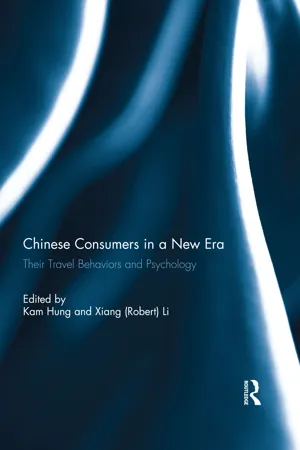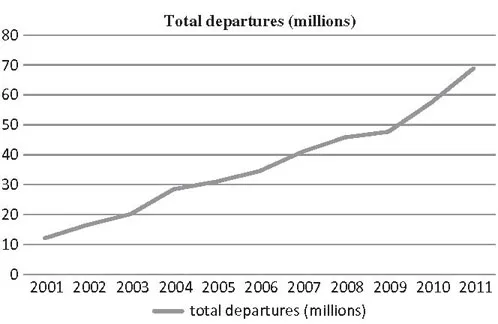![]()
Exploring Chinese Outbound Tourism Motivation Using Means–End Chains: A Conceptual Model
SHAN JIANG
NOEL SCOTT
PEIYI DING
TONY TONGQIAN ZOU
Over the last decade, the Chinese outbound tourism market has experienced rapid development, and understanding the tourism motivations of this growth market is critical to understanding their decision-making processes and tourism behaviors. By reviewing the literature on tourism motivations and analyzing the limitations in this research area, this theoretical article develops a conceptual model based on means–end chain (MEC) theory to study the tourism motivations of Chinese outbound tourists and discusses the associated laddering technique required by the MEC theory. It is argued that exploring tourism motivation with the MEC theory will make both theoretical and methodological contributions to tourism motivation research, as well as provide more meaningful information for understanding Chinese outbound tourists.
Background
Leisure travel for Chinese people was almost nonexistent until 1979, but today China’s tourism industry is among the fastest-growing sector of its economy. The country’s gross domestic product grew from 486 billion yuan (or US$58 billion) in 1981 to 47,156 billion yuan (or US$7,485 billion) in 2011, at an average growth rate of nearly 10% (National Bureau of Statistics of China, n.d.). This growth in tourism demand within China is the result of economic growth, and a large middle-class population with strong purchasing power is emerging in China, especially in major cities such as Beijing and Shanghai. It has been observed in recent years that an increasing proportion of urban household income has been allocated to tourism (Shao, 2012); visa applications have become easier, online reservations are growing, and customer choice has become more Westernized (Tse & Hobson, 2008). As a result, the Chinese outbound tourism market has also experienced rapid development over the last decade (Figure 1). It was reported that China has become a rapidly growing market for outbound tourism in Asia, and many countries even regard it as the source of hope for economic recovery (World Tourism Organization [WTO], 2003).
China is very different from many countries due to its unique culture and language. Their different habits and outlooks have a great impact on Chinese people’s choice of destination and their tourism motivations. Though currently most tourists join group tours and visit several countries in one trip, independent travel and mono-destination holidays are emerging as a new trend for Chinese outbound tourism (China Tourism Association, 2010). It was also found that Chinese travelers are willing to spend large amounts of money during their travels (WTO, 2003). In order to explore China’s outbound tourism market, it is necessary to understand the distinguishing features and characteristics of Chinese consumers to develop tourist products to meet their needs and to conduct marketing and promotion activities. Therefore, exploring the travel motivation of Chinese outbound tourists is an important topic for both tourism researchers and destination marketers, who are eager to understand Chinese tourists’ psychological and cultural characteristics.
In the field of tourism research, it is widely accepted that tourism motivation research is an area still fraught with theoretical problems and it is still difficult to measure unobservable parameters (Dann, Nash, & Pearce, 1988; Hsu & Huang, 2008; Jafari, 1987; Jamal & Lee, 2003; Kluin & Lehto, 2012; Pearce & Lee, 2005). This theoretical article (a) critically reviews mainstream motivation theories to identify their advantages and limitations; (b) introduces means–end chain (MEC) theory from the marketing research field as a new approach to explore tourism motivation by developing a conceptual model in the context of Chinese outbound travel market; and (c) discusses the laddering technique as a means to conducting MEC research.
Figure 1. Chinese outbound departures, 2001–2011. Adapted from China Tourism Industry Statistics Bulletin (color figure available online).
A Review of Tourism Motivation Theories
Tourism motivation is a critical explanatory factor in discovering and understanding tourists’ decision-making processes and behaviors and examining why people travel. However, it is also a very complex research area, and numerous theoretical approaches have been adopted (Crompton, 1979; Uysal & Hagan, 1993). According to psychologists, motivation is “the concept we use when we describe the forces acting on or within an organism to initiate and direct behaviour” (Petri & Govern, 2004, p. 16). In the field of tourism, tourism motivation was defined by Dann (1981) as “a meaningful state of mind which adequately disposes an actor or group of actors to travel, and which is subsequently interpretable by others as a valid explanation for such a decision” (p. 205). The following is a critical review of a number of main theories in tourism motivation, which includes Plog’s psychocentric–allocentric model (Plog, 1974, 2001), Iso-Ahola’s escaping and seeking theory (Iso-Ahola, 1982; Mannell & Iso-Ahola, 1987), Dann’s push and pull theory (Dann, 1977), Pearce’s travel career pattern (Pearce, 2005), and Fodness’s function theory (Fodness, 1994).
Psychocentric–Allocentric Model
Plog (1974) introduced a tourist psychographics system based on the belief that tourists’ travel patterns and preferences are determined by their personality characteristics. His model has been criticized as tautological (Braun, 1989) and explaining nothing (Gnoth, 1997). Plog later revised and refined his model and supported it with data from the annual American Traveller Survey (Plog, 2001, 2002). According to Plog (2001), the general population can be grouped into five types of people, varying from allocentric, to near venture, mid-centric, near dependable, and psychocentric. Allocentric people are intellectually curious and want to explore the world, make decisions quickly and easily, and are more likely to choose new destinations. On the other hand, psychocentric people are restrictive in spending discretionary income and prefer more popular, well-known brands of consumer products and destinations. Plog (2001) asserted that destinations could be placed on the psychographic curve, based on the types of people who visit there the most. Changes in the type of people attracted to a destination based on their personality could help to explain why destinations rise and fall in popularity. Some scholars regarded this model as not a valid proxy to predict or describe life cycle evolution because it uses the psychographic profile of visitors alone (McKercher, 2005) and is not realistic (Chen, Mak, & McKercher, 2011). Moreover, the model as a psychographic tool is limited because it does not consider multiple-motivated behaviors and is unable to explain why different types of tourists visit a single destination.
Escaping and Seeking Theory
Iso Ahola and Mannell developed a social psychological model of tourism motivation (SPMTM; Iso-Ahola, 1982; Mannell & Iso-Ahola, 1987). The SPMTM model suggests that tourism motivation can be categorized into four types: seeking personal rewards, seeking interpersonal rewards, escaping personal environment, and escaping interpersonal environment (Mannell & Iso-Ahola, 1987). The model suggests that seeking and escaping are both part of tourism motivation. The escaping and seeking theory has provided a new perspective to explore travel motivation within the context of leisure and social environment, and it was later supported by other studies (Dunn Ross & Iso-Ahola, 1991; Snepenger, King, Marshall, & Uysal, 2006). However, one criticism of the theory is that it does not explain the underlying reason for escape as the tourism motivation (Jamal & Lee, 2003) and hence fails to address the processes and means by which certain motivations arise rather than others. Second is that Iso-Ahola’s (1982) model does not provide explicit insights into the structure or content of those needs, and it is not a strong predictive tool because it assumes that all people equally share one common need that can be satisfied by intrinsic or extrinsic rewards (White & Thompson, 2009). Thirdly, Iso-Ahola (1982) regarded motivation as “purely a psychological concept” (p. 257), and it is arguable that travel motivation is a part of, or one form of, leisure motivation (Jamal & Lee, 2003). It is generally considered that tourism and leisure motivation overlap to some degree, but there are also many differences between these two fields, and they cannot be studied as one phenomenon. Travel motivation is only partly similar to that found in the leisure domain and is considered worthy of independent theory building (Pearce, 1993).
Push and Pull Theory
Push and pull factors were first proposed by Dann in 1977 and have been widely adopted in tourism research studies (Hsu & Huang, 2008). According to Dann (1981), pull factors are the specific attractions that induce tourists to visit a particular destination rather than another once the decision to undertake a trip has been made (e.g., heritage and culture, beaches, friendly people, etc.), and push factors are internally generated drives that cause the tourist to search for signs in objects, situations, and events that contain the promise of reducing prevalent drives. Push and pull theory is widely used in tourism motivation research (i.e., Crompton, 1979; Jang & Wu, 2006; Kozak, 2002; Yuan & McDonald, 1990).
However, a number of limitations of this theory have been highlighted. First of all, it is not clear in this theory how to define the two factors in terms of their dimensional levels. For example, in Crompton’s study (1979), novelty and education as pull factors, along with push factors such as escape from routine, self-discovery, relaxation, improve family relationships, and facilitate social interaction could be regarded as benefits received from tourism. The push factors of prestige and regression are, however, at a deeper level of motivation and are closer to the values of social reorganization and freedom (Rokeach, 1973). In the work of Yuan and McDonald (1990), again, prestige is regarded as one push factor among other beneficial motivations. However, prestige is not only a benefit but is more of an instrumental value motivation directed toward social recognition as the terminal value.
In addition, the the...



